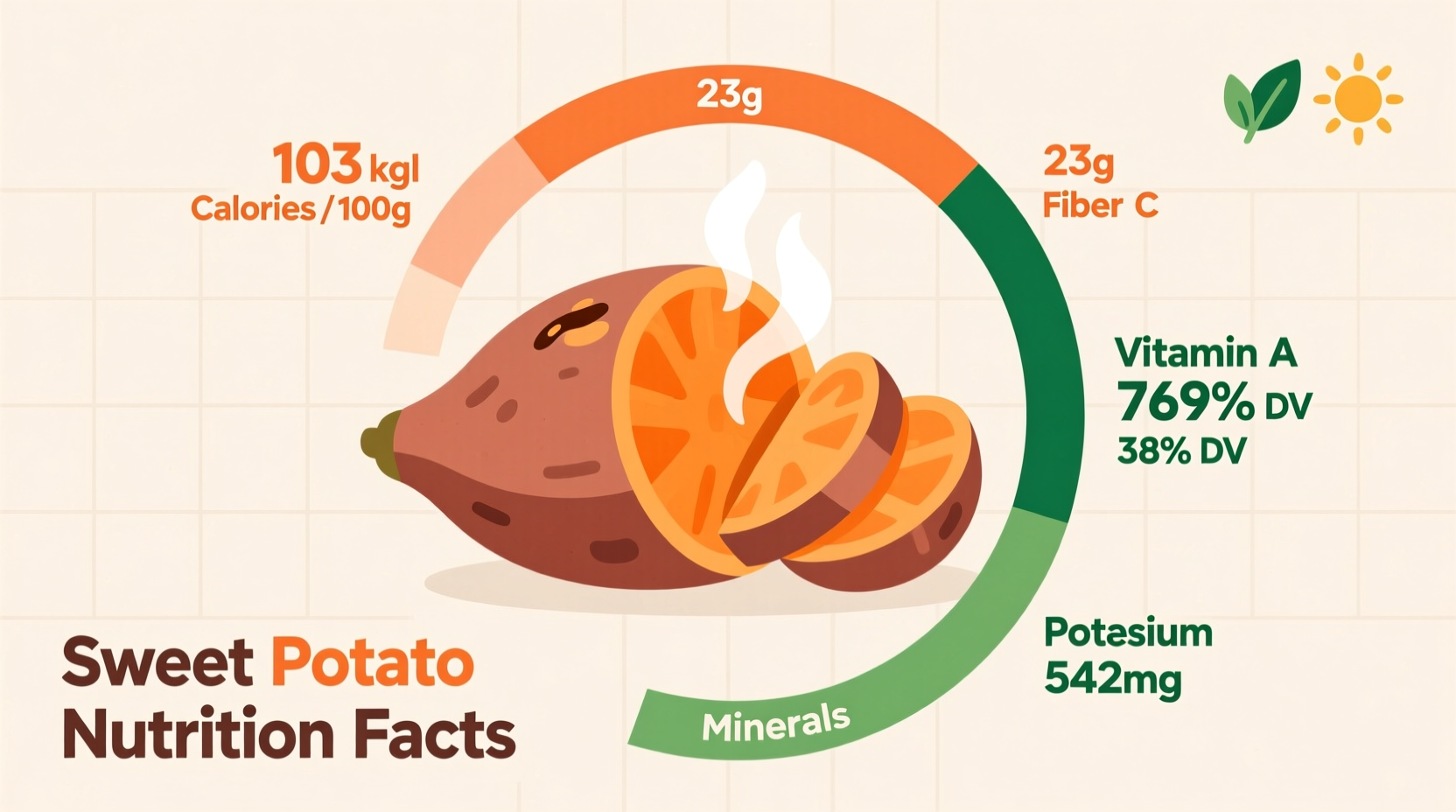One medium sweet potato (130g) delivers 103 calories, 24g of carbohydrates, 4g of fiber, and an extraordinary 438% of your daily vitamin A needs. This nutrient-dense root vegetable also provides significant potassium, vitamin C, and manganese while maintaining a low glycemic index of 44-61 depending on preparation method.
Discover why sweet potatoes consistently rank among the world's healthiest foods. This comprehensive nutritional breakdown reveals exactly what makes this vibrant root vegetable a powerhouse for blood sugar management, immune support, and overall wellness. Whether you're managing diabetes, boosting athletic performance, or simply optimizing your daily nutrition, understanding sweet potato's precise nutritional profile helps you make informed dietary choices.
Complete Nutritional Profile: What's Inside Every Serving
Based on USDA FoodData Central measurements, here's the detailed nutritional composition of one medium sweet potato (130g, baked with skin):
| Nutrient | Amount | Daily Value % |
|---|---|---|
| Calories | 103 | 5% |
| Carbohydrates | 24g | 9% |
| Dietary Fiber | 4g | 14% |
| Sugar | 7g | - |
| Protein | 2g | 4% |
| Vitamin A | 709μg RAE | 438% |
| Vitamin C | 22mg | 24% |
| Potassium | 475mg | 10% |
| Manganese | 0.6mg | 28% |
This nutritional powerhouse contains complex carbohydrates that provide sustained energy release. Unlike simple sugars, sweet potato's natural sugars come packaged with fiber that slows digestion and prevents blood sugar spikes. The vibrant orange color signals high beta-carotene content, which your body converts to active vitamin A as needed.
Health Benefits Backed by Scientific Research
Multiple studies confirm sweet potatoes' impressive health benefits. Research published in the Journal of Medicinal Food demonstrates that sweet potato consumption significantly improves insulin sensitivity in type 2 diabetes patients. The National Institutes of Health notes that the high vitamin A content supports immune function and vision health, particularly important for populations with vitamin A deficiency.
The manganese content (providing 28% of your daily needs) plays a crucial role in bone health and metabolic function. Sweet potatoes' antioxidant profile, including anthocyanins in purple varieties, shows promising anti-inflammatory effects according to research from the USDA Agricultural Research Service.

Sweet Potato vs Regular Potato: Making the Right Choice
Understanding the nutritional differences helps you choose wisely for your health goals:
| Nutrient (per 130g) | Sweet Potato | White Potato |
|---|---|---|
| Glycemic Index | 44-61 | 70-85 |
| Vitamin A | 438% DV | 0% DV |
| Vitamin C | 24% DV | 20% DV |
| Fiber | 4g | 2g |
| Potassium | 10% DV | 15% DV |
While both provide potassium and vitamin C, sweet potatoes offer dramatically more vitamin A and fiber while maintaining a lower glycemic index. This makes them particularly valuable for blood sugar management. White potatoes contain slightly more potassium but lack the powerful antioxidant profile of sweet potatoes.
Maximizing Nutritional Benefits Through Preparation
Your cooking method significantly impacts sweet potato's nutritional value. Research from the Journal of Agricultural and Food Chemistry shows that boiling preserves 92% of beta-carotene compared to 75% when baking. However, baking enhances the natural sweetness and creates beneficial resistant starch when cooled.
For maximum nutrient absorption:
- Leave the skin on (contains 3x more fiber than flesh)
- Add a small amount of healthy fat (olive oil, avocado) to boost vitamin A absorption
- Avoid excessive frying which adds unnecessary calories
- Cool cooked sweet potatoes to increase resistant starch content by 30%
Practical Incorporation Strategies for Daily Nutrition
Adding sweet potatoes to your diet doesn't require complicated recipes. Registered dietitians recommend these simple approaches:
For blood sugar management: Pair with protein sources like Greek yogurt or chicken to create balanced meals. The American Diabetes Association suggests keeping portions to 1/2 cup diced sweet potato per meal for optimal glucose control.
For athletic performance: Consume within 45 minutes after exercise. The carbohydrate-to-protein ratio in sweet potatoes supports muscle recovery while providing sustained energy for your next workout.
For immune support: Combine with vitamin C-rich foods like bell peppers or citrus. This pairing enhances iron absorption from plant sources while boosting your body's defense mechanisms.
Contextual Considerations: When Sweet Potatoes May Not Be Ideal
While generally beneficial, certain health conditions require moderation. Individuals with kidney disease monitoring potassium intake should consult their healthcare provider about appropriate portions, as sweet potatoes contain 475mg potassium per medium serving. Those following extremely low-carb diets may need to limit portions due to the 24g carbohydrate content.
The glycemic index varies significantly based on preparation method - boiled sweet potatoes have a GI of 44 while fried versions can reach 94. Understanding these context boundaries helps you make informed choices based on your specific health needs.
Evolution of Sweet Potato Consumption Patterns
Sweet potatoes have transformed from traditional staple food to nutritional superstar. Historical USDA data shows American consumption increased 37% between 2010-2020 as awareness of their health benefits grew. This shift reflects broader dietary trends toward whole, minimally processed foods with proven health benefits.
Nutrition researchers note that modern varieties contain 20% more beta-carotene than those grown 30 years ago, thanks to selective breeding focused on nutritional density rather than just yield. This evolution demonstrates how agricultural science continues improving the nutritional value of traditional foods.
Frequently Asked Questions
Do sweet potatoes raise blood sugar levels significantly?
Sweet potatoes have a moderate glycemic index (44-61) depending on preparation method. Boiled sweet potatoes have the lowest impact (GI 44), while fried versions can reach 94. The high fiber content (4g per serving) slows sugar absorption, making them suitable for most blood sugar management plans when consumed in appropriate portions (typically 1/2 cup).
How does cooking method affect sweet potato nutrition?
Boiling preserves 92% of beta-carotene compared to 75% when baking. However, baking creates beneficial resistant starch when cooled. Steaming maintains the highest vitamin C content. Avoid deep frying which adds unnecessary calories and reduces overall nutritional value. For maximum nutrient absorption, always include the skin and pair with healthy fats.
Are sweet potatoes better than white potatoes nutritionally?
Sweet potatoes provide dramatically more vitamin A (438% DV vs 0%) and fiber (4g vs 2g) while having a lower glycemic index (44-61 vs 70-85). White potatoes contain slightly more potassium (15% DV vs 10%). Both provide vitamin C, but sweet potatoes offer superior antioxidant profiles. The "better" choice depends on your specific nutritional needs and health goals.
Can I eat sweet potatoes daily as part of a healthy diet?
Yes, most healthy adults can safely enjoy sweet potatoes daily. A medium sweet potato (130g) fits within standard dietary recommendations. Those monitoring potassium intake due to kidney conditions should consult their healthcare provider about appropriate portions. For balanced nutrition, vary your vegetable intake while including sweet potatoes regularly for their unique nutrient profile.
What's the best way to store sweet potatoes for maximum freshness?
Store sweet potatoes in a cool, dark, well-ventilated place (55-60°F/13-15°C) for up to 3-4 weeks. Never refrigerate, as cold temperatures convert starches to sugars prematurely. Keep them away from onions which release gases that shorten shelf life. Check regularly for soft spots or sprouting, which indicate spoilage. Properly stored sweet potatoes maintain optimal texture and nutritional value.











 浙公网安备
33010002000092号
浙公网安备
33010002000092号 浙B2-20120091-4
浙B2-20120091-4